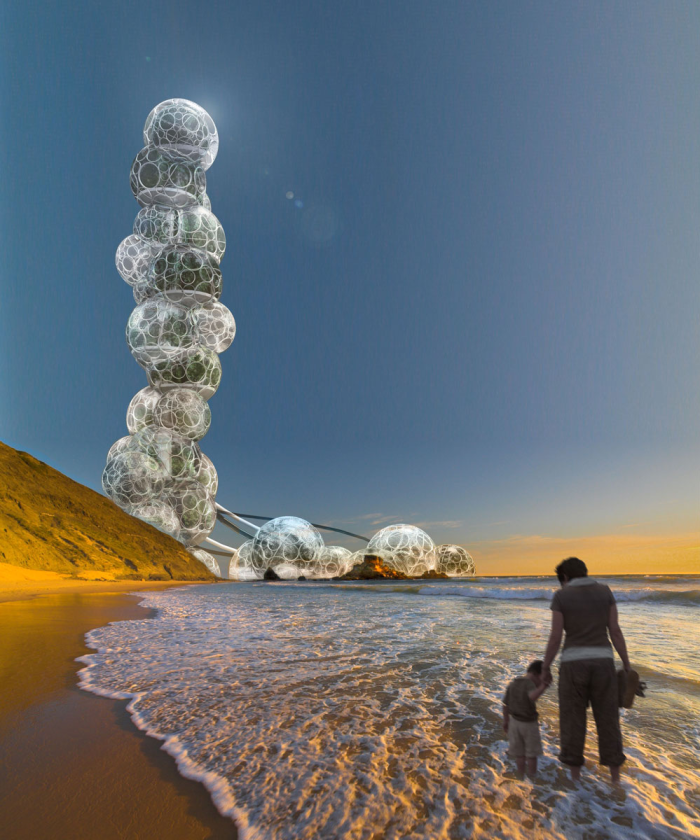Nicolas Chausson, Gaël Desveaux, Jiao Yang Huang, Thomas Jullien;
As you might know, although water is very present on earth, 97% is salted and 2% is blocked as ice. Actually, there is only about 1% left of liquid freshwater and the UNO and the World Water Council estimate there might be a crisis affecting half the worldwide population by 2030. Freshwater will be a major stake in the 21st century. Indeed the production of a daily food intake for a human being requires 3000 liters of freshwater and the annual rate of freshwater needs is 64 billions cubic meters.
Farming makes up 70% of the worldwide freshwater consumption. Our proposal is a totally new building: an unseen response to sustainable development and the up coming stakes.
The tower is made of several circular tanks filled with brackish water. These tanks are sheltered in spherical greenhouses. The brackish water is brought up in the tower by tidal powered pumps. The water pipes network is incorporated in the tower main structure. The tanks are planted with mangroves: these plants have the particularity to grow on brackish water and to sweat freshwater. So, the mangroves feed on brackish water and then their leaves perspire freshwater. This freshwater sweat evaporates in the greenhouse and condensates by the night into dew on the sphere plastic wall to be collected in a freshwater tank. Then, thanks to its at altitude storage, the produced freshwater can be distributed to the fields by gravitational flow. The total surface of the tower is one hectare. One hectare of cultivated mangroves should produce 30000 liters of freshwater a day. For example, the tower will be able to irrigate a one-hectare field of tomato a day.
Tahmin edilebileceği gibi, hernekadar Dünya’nın büyük bir kısmı sularla kaplı olsada, bu suların %97’si tuzlu, %2’si ise buzullarda kitlidir. Tüm bu suların sadece %1’i içilebilir su niteliğinde olup, Dünya Su Konsülünce 2030 yılı civarında dünya nüfusunun yarısı temiz ve içilebilir su krizi içinde olacağını ön görülür. Kısacası temiz ve taze su çağımızın en önemli problemlerinden biridir. Üstelik içilebilir su ihtiyacının yanı sıra, besinlerin üretimi ve tarım için kullanılacak suda katılınca durumun ciddiyeti daha belirgin olacaktır.
Taze suyun %70’i tarımda kullanılmaktadır. Bu nedenle bu projede tarım için sağlanacak taze suyun, deniz suyundan sağlayabilecek bir kule (yada gökdelen) önerisi geliştirilmiştir.
Kule aslında, içi tuzlu su ile dolu dairesel tank olan bir çok küresel seranın bileşiminden oluşur. Tuzlu su kuledeki tanklara, borularla, denizlerdeki gelgitlerin gücü ile pompalanıyor. Su borularından oluşan ağ kulenin ana yapısını oluşturur. Tankların içine, tropikal kuşaktaki kıyı ve bataklıklarda yetişen bir bitki cinsi olan mangrov ekilecektir, çünkü bu bitki özellikle tuzlu suda ve çok nemli hava koşullarında yetişebilmektedir. Bu bitki tuzlu suyla beslenip, yapraklarından taze ve temiz su terleyecek ve bir tür doğal su arıtma aracı olacaktır. Yapraklardaki bu taze su daha sonra sera içinde buharlaşacak ve seranın küresel duvarlarında çiğler (su damlaları) birikecek. Ve bu biriken su damlaları küresel duvarın kenarlarındaki tanklarda toplanacaktır. En sonunda, tanklarda toplanan bu taze sular, kulenin çevresinde bulunan tarım alanlarına, yerçekimi yardımı ile dağıtılacaktır. Kuleyi oluşturan Küresel Seraların yüzeylerinin toplamı 1 hektar kadardır. 1 hektarlık alanda ekilmiş mangrov bitkisi, günde 30 bin litre temiz su üretebileceği hesaplanmış. Mesela bu kulede üretilen taze su ile 1 hektarlık domates tarlası hergün sulanabilir.

